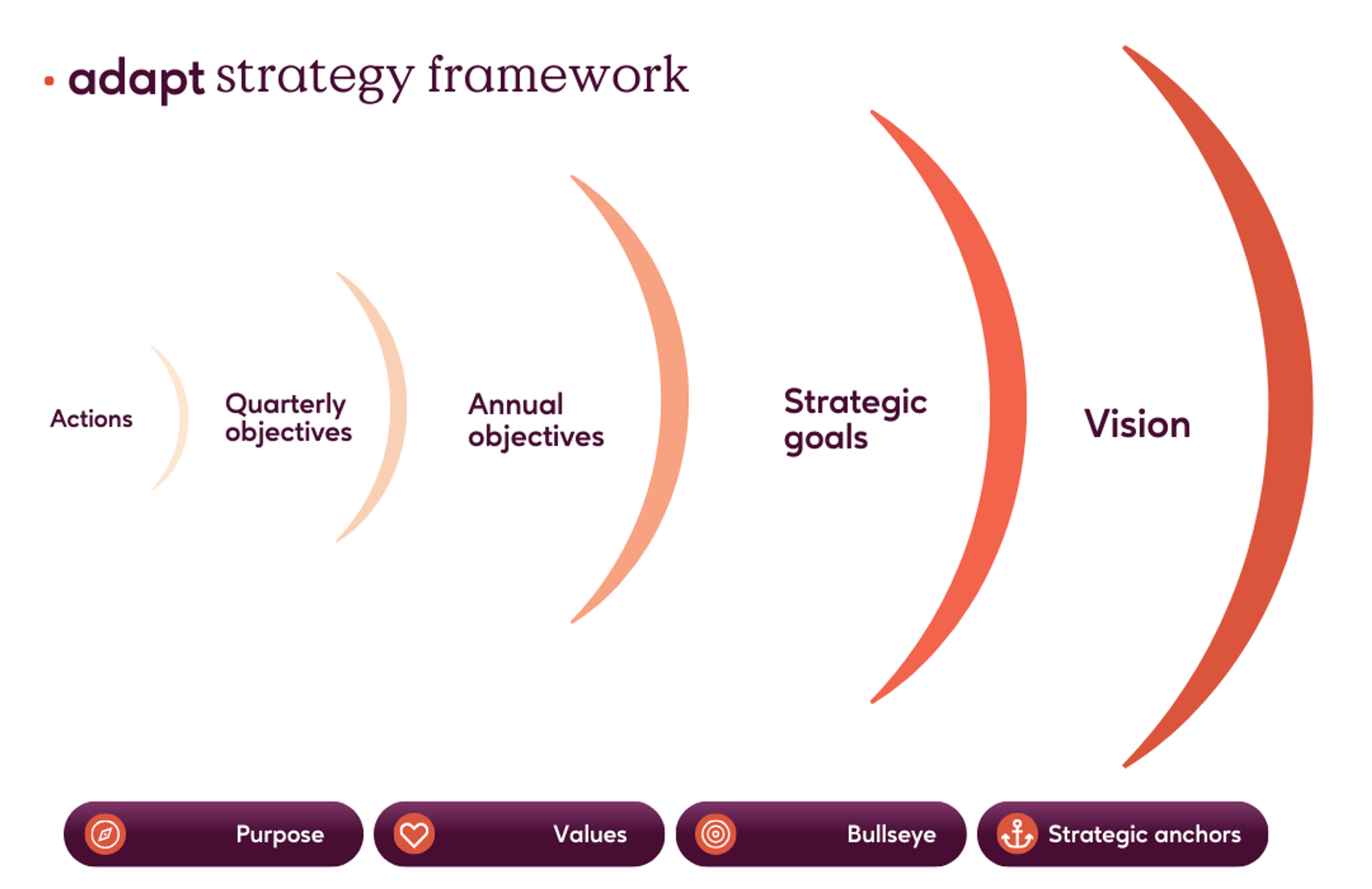The Fundamentals of Strategic Planning

Build your strategy for success!
What is strategy? A simple definition is:
A plan of action designed to achieve a long-term goal or vision.
This can apply to war, business, sports or personal life.
Richard Rumelt author of ‘Good Strategy, Bad Strategy’; defines strategy as:
A set of objectives, policies and plans that, taken together, define the scope of the enterprise and its approach to survival and success.
There is good strategy and there is bad strategy. Good strategy requires discipline and rigour. It is not a one-time event and it’s not easy.
The key elements of a good strategy
- Articulate the vision and goals that make the future state as clear as possible to everyone in the business.
- Set solid foundations. Be clear about what you are about, your purpose and your values.
- Make a realistic assessment of the current state by understanding the internal and external environment.
- Diagnosis of the gap between current and future state. What are the obstacles and challenges that need to be overcome and the strengths and opportunities that can be leveraged to move from the current to the future state?
- Develop a coherent approach to closing the gaps. Clear objectives and actions.
- Marshall your business’s knowledge, resources and energy to implement your plan.
- Measure outcomes, review and adapt. Continuously assess the effectiveness of your strategy and adapt as necessary in response to changing circumstances.
A characteristic shared by most SME’s is that they are resource-poor or at the least resource-tight. A good strategy is like a lever that magnifies force, it gives a business focus and concentrates resources, energy and actions on the critical few things that can make the biggest impact. Good strategy requires that leaders stay focused and say no to allocating resources to the wide variety of actions and interests that will arise.
The strategic planning process we encourage is NOT a rote exercise. It’s a framework for stimulating disciplined thought, guiding you and your team as you gain insights and set the direction for the business. The process is repeated every quarter to continue to build and adapt your strategy in line with the changes that happen in and around your business.
Good strategic planning is about the search for the right questions. You can’t hope to get the right answers if you don’t ask the right questions.
Adapt HQ guides you through a series of pathways that will support you and your leadership team to ask the right questions and take a step-by-step approach to build your strategy. A reminder that the steps are not linear, you will need to circle around again and again as you debate and test your thinking.
Effective planning involves looking at the brutal facts both internal and external to your business, then seeking insight and then debating these facts from which you will make a series of decisions, act on those decisions then repeat this exercise – every quarter. Adapting your plan each time and focusing on future actions in response to the wins and misfires of your previous decisions.
A note about who to involve in this process.
The team of people you have around you is critical to the successful development of a good strategy. Those around you must be dedicated to the success of the business above their own or their department's interests. There needs to be a high level of Trust and Psychological Safety in the room so people can feel safe sharing ideas and engaging in healthy debate.
Strategic planning is not a science, it is a creative process. Insights will come if the team are open and have enough trust to engage in rigorous debate. Insight does not come from head nodding!
Asking the right questions
- Why do we exist?
- What is the core purpose of your business?
- How do we behave?
- A clear set of values that support the behaviour and culture you want for your business.
- Where are you going?
- What is your vision for the business?
- What are your medium-term goals?
- What do you do? And what do you NOT do?
- Where do your passions and talents intersect with what the customer values
- What’s our current state?
- A realistic assessment of your current situation working through Strengths/Weaknesses/Trends or Competitors Analysis and other inputs to gain insight.
- What will anchor our strategy?
- What inherent strengths, knowledge and talents do we have that the customer values and we can leverage to keep a competitive advantage?
- What is the gap between our current state and our future, desired state?
- Analyse the gap to understand the obstacles and weaknesses that need to be overcome and the strengths and opportunities that can be leveraged.
- What is our strategy to bridge the gap?
- Set focused objectives and key results to ensure everyone in the business is focused and clear on the strategic priorities. This will help ensure your mental energy, actions and resources are all pulling in the same direction.
- Who needs to do what?
- A strategic plan without clear actions and accountabilities is nothing but a daydream. We are going to help you and your leadership team build a culture of discipline and accountability in executing your plan.
Bad strategy
Sadly, more businesses have a bad strategy than a good strategy. Why?
- Failure to make a realistic assessment of the current state.
- Not facing the brutal facts. Not gathering internal and external inputs.
- Lack of focus.
- Having too many or incompatible, competing goals.
- Failure to know and respect the competition.
- Failure to keep abreast with market changes.
- Unwillingness or inability to choose.
- You won’t get the focus unless you can make a choice. This might mean setting aside some goals and objectives in favour of others.
- Failure to make a good analysis of the gap between the current state and the desired future state.
- Blinkers on, inability or unwillingness to adapt to changing circumstances
Strategy inside adapt
Adapt HQ is broken up into a series of pathways designed to answer the questions above. Each pathway asks questions of the owner and the leadership team - and is designed to uncover the challenges and opportunities you have in your business to achieve your vision and goals. It is a process of diagnosing, discussing and debating; experiencing collective insights, and creating guidelines and focused actions.
The diagram below shows the components of the strategy that contribute to building your strategy using our framework.




